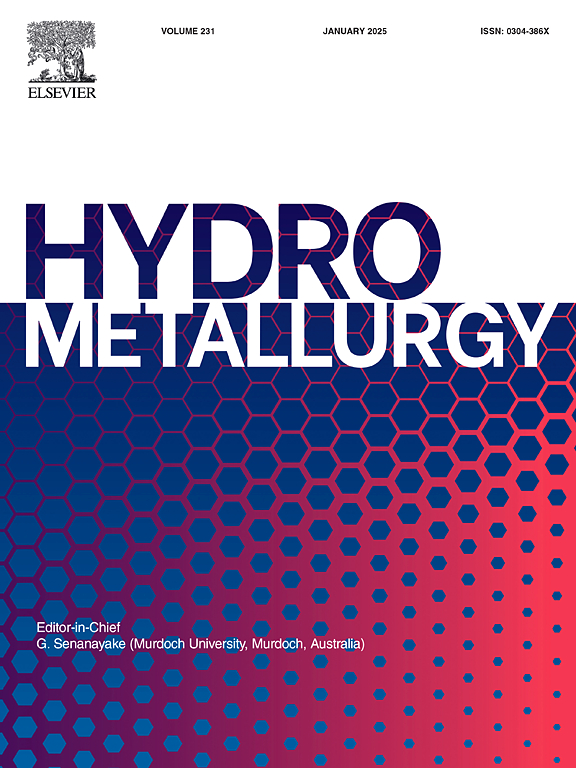Direct extraction of lithium from a salt-lake brine of low-chloride and high‑calcium using a TBP-FeCl3 solvent extraction system and stripping with HCl
IF 4.8
2区 材料科学
Q1 METALLURGY & METALLURGICAL ENGINEERING
引用次数: 0
Abstract
The increasing adoption of lithium-ion batteries in new energy sectors has substantially increased lithium consumption. Chilean salt lakes consist of high concentrations of Li+, (1.14 g/L) and Ca2+ (>10 g/L) and low concentration of Cl− (<200 g/L). The TBP-FeCl3 system can efficiently extract lithium from high Mg brine, but the system has not yet been studied in low chloride and high calcium brine. In this paper, the effect of different extraction, scrubbing, and stripping conditions on the lithium extraction percentage from this type of brine was investigated using a TBP-FeCl3 system. The results indicated that 100 % TBP mixed with brine containing 15–20 g/L Fe3+ and 0.05 mol/L HCl at O/A = 1:1, extracted 52.9 % of Li+ and produced an organic phase of 0.72 g/L Li+, accompanied by Ca2+ and Na+ concentrations of 2.82 g/L and 2.47 g/L, respectively. The extraction percentage of Li+ reached 74.2 % after a four-stage extraction process. The loaded organic phase was scrubbed with 4 mol/L LiCl solution at O/A = 1:1, and the scrubbing percentage of the impurity ions was >90 %. The scrubbed organic phase was stripped by simulated counter-current stripping by 2.5 mol/L HCl at O/A = 15:1 for ten stages, and the recovery of Li+ was 80.3 %. The stripping solution had a Li+ concentration of 25.3 g/L and an impurity ion concentration of <1 g/L and the loss of Fe3+ was <100 mg/L. The TBP-FeCl3 extraction system offers the efficient and direct extraction of lithium from Chilean brine and provides technical support for the clean mining of lithium resources in South American salt lakes.
用TBP-FeCl3溶剂萃取系统和HCl萃取直接从低氯高钙盐湖卤水中提取锂
锂离子电池在新能源领域的日益普及,大大增加了锂的消费量。智利盐湖由高浓度的Li+ (1.14 g/L)和Ca2+ (>10 g/L)和低浓度的Cl - (<200 g/L)组成。TBP-FeCl3体系可以有效地从高Mg卤水中提取锂,但该体系在低氯高钙卤水中的研究尚未开展。本文采用TBP-FeCl3体系研究了不同萃取、洗涤和汽提条件对该类卤水锂提取率的影响。结果表明,100% TBP与含15 ~ 20 g/L Fe3+和0.05 mol/L HCl的卤水在O/A = 1:1的条件下混合,Li+的提取率为52.9%,生成的有机相Li+为0.72 g/L, Ca2+和Na+的浓度分别为2.82 g/L和2.47 g/L。经过4段萃取,Li+的提取率达到74.2%。负载有机相用4 mol/L LiCl溶液按O/A = 1:1洗涤,杂质离子洗涤率为90%。用2.5 mol/L HCl在O/A = 15:1条件下模拟逆流汽提,共10级,Li+回收率为80.3%。溶出液中Li+浓度为25.3 g/L,杂质离子浓度为1 g/L, Fe3+的损失量为100 mg/L。TBP-FeCl3萃取系统可从智利卤水中高效、直接地提取锂,为南美盐湖锂资源的清洁开采提供技术支持。
本文章由计算机程序翻译,如有差异,请以英文原文为准。
求助全文
约1分钟内获得全文
求助全文
来源期刊

Hydrometallurgy
工程技术-冶金工程
CiteScore
9.50
自引率
6.40%
发文量
144
审稿时长
3.4 months
期刊介绍:
Hydrometallurgy aims to compile studies on novel processes, process design, chemistry, modelling, control, economics and interfaces between unit operations, and to provide a forum for discussions on case histories and operational difficulties.
Topics covered include: leaching of metal values by chemical reagents or bacterial action at ambient or elevated pressures and temperatures; separation of solids from leach liquors; removal of impurities and recovery of metal values by precipitation, ion exchange, solvent extraction, gaseous reduction, cementation, electro-winning and electro-refining; pre-treatment of ores by roasting or chemical treatments such as halogenation or reduction; recycling of reagents and treatment of effluents.
 求助内容:
求助内容: 应助结果提醒方式:
应助结果提醒方式:


